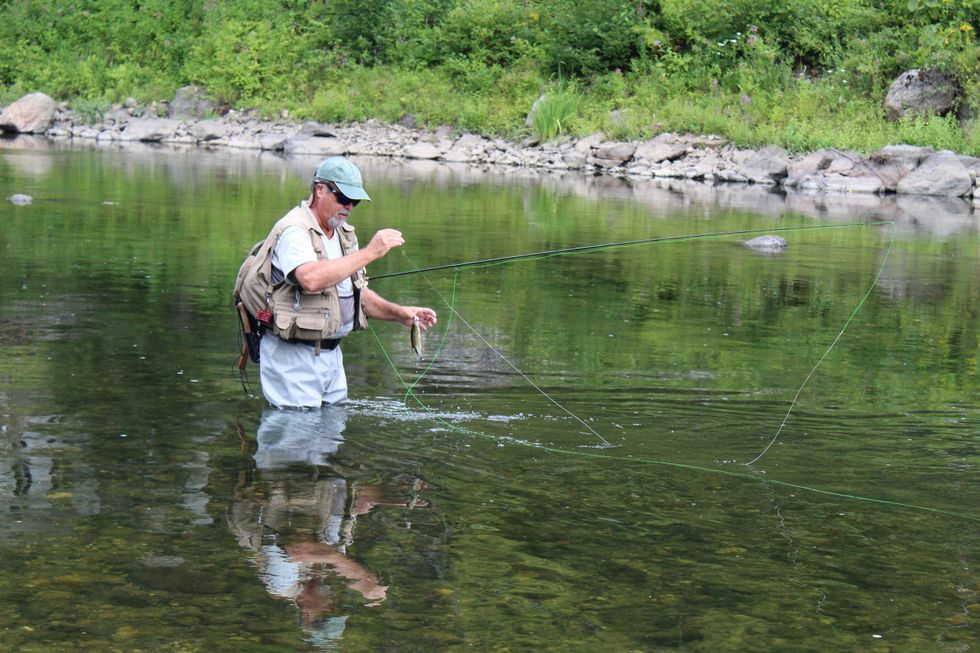Mapping known ‘wildlands’ in New England


A collective called Wildlands, Woodlands, Farmlands & Communities, which focuses on land conservation and environmental protection in New England, recently released a first-of-its-kind report mapping and describing all known wildlands in the region.
“Wildlands” refers to an area of any size and condition, permanently protected from development, in which management explicitly intends to allow nature to prevail with minimal human interference. Essentially, a wildland is a tract of land that is able to exist as it did before rapid industrialization put a strain on the environment throughout the region.
“Wildland conservation, like all of conservation, is only necessary due to unchecked development and destructive practices — first introduced to this region by colonizing people — that have threatened all natural systems and society itself,” the report reads. “As a complementary strategy to protecting Woodlands (actively managed forests) and farmlands, there are myriad reasons to protect Wildlands.”
These areas not only offer habitats for local wildlife and plant species, but provide critical infrastructure for slowing the effects of climate change. Right now, only about 25% of New England land is protected from development. The report’s authors argue that that figure must reach 80% to ensure the environmental future of the region.
“From Acadia National Park, Baxter State Park and the Wilderness areas in the White and Green Mountains to the state reserves and forever-wild easements on private lands, a thriving, diverse and much more expansive network of Wildlands is vital for counteracting the global crises of climate change, biodiversity loss and their impact on human welfare,” said report co-author David Foster, director emeritus of the Harvard Forest in Petersham, Massachusetts, and former president of the Highstead Foundation in Redding, Connecticut, in a statement.
Trees in wildland tracts remove carbon from the atmosphere and store it in their trunks, branches, leaves and roots. Less carbon in the atmosphere means fewer effects from greenhouse gas, which means less heat will be trapped in Earth’s atmosphere. Wildlands also enhance landscape resilience to stresses from climate change, biodiversity loss, and habitat fragmentation. Finally, wildlands form a central component of “30 x 30,” the nationally and internationally embraced goal to protect 30% of the land and waters of the Earth by 2030.
The report calls for planners to center wildlands in their approaches, while also strengthening existing wildlands through permanent protection and landscape buffering.
Through public and private action, planners can also create more wildlands to sustain New England through what the report calls “an integrated conservation agenda.”
The collective suggests accomplishing its goals through seven pathways, which include expanded collaboration, education and outreach, community engagement, funding, research, accessibility and policy.
Connecticut is home to just over 2% of the region’s wildlands, many of which buffer the Appalachian Trail in the remote and rural northwestern corner. Among the state’s wilds are the Canaan Mountain Wilderness Area Preserve, a 2,260 acre expanse nestled in the rugged, high-elevation section of Housatonic State Forest; the McLean Game Refuge, just a half hour outside of Hartford in North-Central Connecticut; and the Connecticut College Natural Areas, three parcels of forest and salt marsh totaling about 200 acres, in the state’s coastal lowland.
Other Connecticut wildlands include the Department of Energy and Environmental Protection’s (DEEP) Old Forest Management Sites, like Gold’s Pines Natural Area Preserve in West Cornwall and Wangum Lake in Canaan and more. But the collective that issued the report said the protection DEEP can offer these wildlands doesn’t go far enough.
The report shows that while 81% of New England is forested, only a miniscule portion has been designated as protected wildlands.
In order to reach the collective’s goal of permanently protecting 80% of New England in a mixture of natural wildlands (at minimum 10%), productively managed woodlands (60%), farmland (7%), and other (up to 3%) by 2060, each state has to increase its pace of forest conservation. Connecticut in particular must increase its rate the most and more than quadruple the amount of acres it protects per year.
The cast of 'Once Upon a Mattress' at Sharon Playhouse.
In 2025, the pages of Compass tracked the steady hum of creativity across the Northwest Corner. Here’s a look at some of the highlights that shaped the year.
ART
The Hotchkiss School marked 50 years of co-education with The Art of Joy Brown, a sweeping retrospective honoring the internationally celebrated sculptor. Opening Feb. 22 in the Tremaine Art Gallery, the exhibition traced Brown’s five-decade journey from her early pottery training in Japan to the large-scale bronze figures now installed around the world — and newly on the Hotchkiss campus.
Millbrook School hosted the first-ever Firefly student artist showcase in February, bringing together young artists and bird enthusiasts from schools across New York and Connecticut.
The David M. Hunt Library’s Art Wall continued to feature local artists, including Jon Kopita, who displayed a decade of his meticulous, repetitive hand-lettering exploring order and identity.
A collaboration between The Nutmeg Fudge Company, artist Gerald Incandela, and Saint John Paul the Great Academy resulted in a vibrant student-designed mural in Torrington.
Great Barrington marked a major milestone this year with the unveiling of a life-sized bronze sculpture of W.E.B. Du Bois in front of the Mason Public Library. Created by National Sculpture Society honoree Richard Blake, the piece anchors a redesigned public plaza.
The Wassaic Project received a $100,000 multi-year operating grant from Foundations for Community Health and Amy Wynn stepped down Oct. 31 as the first executive director of the American Mural Project (AMP) in Winsted.

BOOKS
We welcomed new freelance writers Laurie Fendrich and Olivia Prager who covered the region’s robust literary scene. Highlights included Ann Temkin at Cornwall Library; Ruth Franklin at Congregation Beth David; Elias Weiss Friedman (AKA “The Dogist”) at Troutbeck; Gwen Strauss at the White Hart Speaker Series; and the return of the Haystack Book Festival in Norfolk.Books & Blooms celebrated its tenth anniversary in June with a two-day celebration of gardens, art and the rural beauty of Cornwall.
FILM
The Triplex in Great Barrington hosted screenings, festivals and conversations throughout the year, from a Bob Dylan biopic talkback with Seth Rogovoy to student screenings of “Selma,” benefit events and the launch of the Queer Cinema Club. The Stissing Center expanded film programming with a new projector and a short-film festival featuring local artists and the Moviehouse in Millerton continued its incredible programming.
Legendary civil rights activist Dolores Huerta sat down with The Journal in October in advance of the screening of “Dolores” in Norfolk, the documentary by Peter Bratt and executive producer Carlos Santana that presents an unflinching portrait of a woman whose voice, body and will shaped the political terrain of the United States.

MUSIC
From brass bands and local musicians at street fairs and green spaces to classical and chamber music series presented by organizations from Music Mountain to Tanglewood, music was a staple of the Compass calendar.
The Twelve Moons Coffeehouse in Falls Village continues its once-a-month series that consists of a robust open mic followed by a featured performer.
The American Mural Project’s live music and Happy Hour Piano Series was also a monthly anchor that featured a multitude of styles of music.
The Indigo Room, a new performance space connected to The Mahaiwe in Great Barrington, opened in the beautifully restored historic firehouse next door, offering a smaller space for intimate performances. The Mahaiwe continued to delight with programming that included greats like Old Crow Medicine Show, Paquito D’Rivera, Natalie Merchant, Roseanne Cash and many more.
Crescendo, the award-winning organization that brings works from the Renaissance and Baroque periods to new life, launched its 22nd season with performances at Saint James Place in Great Barrington and Trinity Church in Lakeville.
Rufus Wainwright performed a benefit concert for Out for Dutchess at The Stissing Center.The beloved Race Brook Lodge in Sheffield hosted its final Fall Gratitude Festival before closing its storied doors.

COMMUNITY
Trade Secrets celebrated its 25th anniversary with record crowds. The annual event, benefiting Project SAGE, featured over 50 vendors and special attractions like a signing of Martha Stewart’s gardening book, following a day of local garden tours.
Scenic bike routes were explored in these pages and Kerri Lee Mayland’s offerings on design are a delightful new feature. Dee Salomon’s column “The Ungardener” continues to inform and delight and community events such as the Farm Fall Block Party at Rock Steady Farm in Millerton kept readers connected to local farm life.
THEATER
The Sharon Playhouse delivered a lively season of classic musicals, sharp comedies and community-centered work. Highlights included “Million Dollar Quartet,” a popular run of “Annie,” A.R. Gurney’s “Sylvia” and a fall staging of Agatha Christie’s “The Mousetrap.” The Writers Playground Festival championed new short plays by local writers, while the YouthStage program mounted family favorites like “Once Upon a Mattress,” “Finding Nemo Jr.” and “101 Dalmatians Kids,” giving young performers steady opportunities onstage. The Playhouse also welcomed new managing director, Meghan Flanagan.
The Ancram Center for the Arts celebrated its 10th anniversary. Highlights included the “Real People Real Stories” series, the regional premiere of “Where the Mountain Meets the Sea,” and Plein Air Plays 3.0, which brought original short plays to surprise outdoor locations. The Center also advanced new work through its Play Lab Residency, featuring David Cale’s “Blue Cowboy” and “Framed,” a new musical by Ancram local Mary Murfitt with music by Murfitt and Pam Drews Phillips.
In May, Richard Maltby Jr.’s “About Time” opened at Goodspeed’s Terris Theatre. He spoke with us about the deeply personal revue, describing it as a meditation on aging, memory and the strange clarity of life’s “third act.”
The Stissing Center continued to expand its theatrical footprint in 2025, presenting a mix of classic drama, new work and intimate staged readings. Highlights included Theatre On the Road’s atmospheric “Dracula,” a summer run of the off-Broadway musical “Kafkaesque!,” and Tangent Theatre Company’s reading of Harold Pinter’s “Betrayal.”
Highlights of theater at Hotchkiss in 2025 included a spring premiere of “R.I.P. Lunch,” an original play by alumna Mallory Jane Weiss, and a lively fall production of the musical “Pippin.” Housatonic Valley Regional High School also had a strong theater year in 2025, highlighted by a spring production of “Urinetown” that earned statewide recognition, summer performances through the Grumbling Gryphons Theater Arts Camp, and student apprenticeships at Sharon Playhouse. We also welcomed new writers Annette Stover and Richard Feiner who have beautifully expanded our theater coverage.
Jumpfest 2025
There’s just one month until Jumpfest’s 100th anniversary weekend of ski jumping in February, and the celebration is already underway. For the first time, Jumpfest organizers have launched a community restaurant month as part of the milestone event, running from Jan. 4 through Feb. 4, inviting locals and visitors alike to dine around town in the lead-up to the historic jumps.
The inaugural promotion includes 42 participating restaurants across the Northwest Corner, ranging from cafés to pubs. Participating spots include The White Hart Inn, Black Rabbit Bar & Grille, Roma’s Pizza, Sweet William’s Coffee Shop, The Boathouse, and The Woodland, among many others.
Diners can take part by downloading an entry form at jumpfest.org/100/one-month-to-the-jumps or picking one up at participating eateries. To be eligible to win, participants must visit as many participating restaurants as possible during the month-long promotion. The five diners who visit the most restaurants will each receive a free ticket to Jumpfest 2026, celebrating the event’s 100th year of ski jumping. Completed entry forms must be submitted by 4 p.m. on Feb. 4 at the Salisbury General Store on Main Street, with winners announced the following day.
The all-volunteer Salisbury Winter Sports Association (SWSA) has hosted ski jumping on Satre Hill in Salisbury since the 1920s, keeping alive one of the few Eastern U.S. ski jump venues and introducing generations to the sport.
So grab your appetite and eat your way to the jumps — no skis required.
Gary Dodson casting at dawn on the Salmon River in Pulaski, New York in late April. It was cold but it sure looked nice.
I was very optimistic as winter loosened its grip in the early part of 2025. I had a couple new rods to play with, my rotator cuff problem on my casting arm was resolved in a satisfactory manner, and I joined a private fishing club in the Catskills and was looking forward to exploring new water.
Some of the exploring and trying new things with new rods happened, but a lot of it did not. I blame Nature.
(Listening to anglers complain about the weather is as tedious as it gets, so feel free to skip the next bit.)
Just for laughs I plotted out the Housatonic flow from April 1 to Nov. 22 on the United States Geological Survey website. What I got back was an inverse bell curve, with high flows at the extremes and a long period of very low flows in between.
Amazingly, this corresponds to the rain, or lack thereof, between April 1 and Nov. 22. It’s just science.
So, looking back at the Tangled archives and my own hastily scribbled journal notes, I see that I started out when the snow and ice were still on the ground on the Blackberry in North Canaan and Macedonia Brook in Kent.
I do remember trying out a short rod, 6-feet 10-inches, from Zen Tenkara. I used it with two-fly rigs, including weighted flies, which should not work in theory, but it did in practice. The biggest problem was when a guy in the parking lot asked me what it was. I said, “It’s a Hachi” and the guy said, “Gesundheit.”

I had an interesting encounter with a couple of DEEP guys who were putting some brown trout fry in the Blackberry, since they had them to spare and were wondering what would happen. I suggested that they would get eaten up fairly quickly by the adult trout and they agreed but did it anyway.
The private water was a bust. There’s no other way to put it. I got there three times all year, and by the beginning of July the drought had settled in and the stream was nothing but a trickle.
I’m going to reup because I enjoyed meeting my fellow club members and the nice landowners who allow us to barge around their properties This year I’m going to hit it often and hard in May and June, circumstances allowing.
My Catskill fishing buddy Gary Dodson has got the big fish bug bad. We went back to Pulaski in late April and I caught a steelhead using a decadent and depraved method called “plugging.” I’m glad to have done it once and feel zero need to do it again.
I’ve had an 11-foot-4 weight switch rod kicking around for a few years. I never knew how to rig it up. In the two-handed rod world, the line weight designation means diddly. It’s all about grains and different tips and all this stuff that I just don’t want to learn.
Since Gary was already down in that rabbit hole I just gave him the rod, a big inexpensive Redington reel and asked him to get the appropriate lines and tips and set it up for me. Which he did, for about $150.
And I got to deploy it on the water precisely once in September before…
My right hip got the Gang Gong from the medical profession.
Yep. By the time this is published, I will have had my new right hip for about a month.
At this rate I’m going to be about 40% after-market parts.
So the entire autumn fishing routine, normally a happy and productive time, was shot to hell. My hip worked just enough to let me know that the kind of aggressive and active fishing I like to do was out of the question.
So apart from fiddling around in a half-hearted way with the fall stockies on the Blackberry in October, I spent the fall and early winter sitting around watching YouTube fish videos and plotting and scheming for all the excellent fishing adventures I will have with my new right hip.